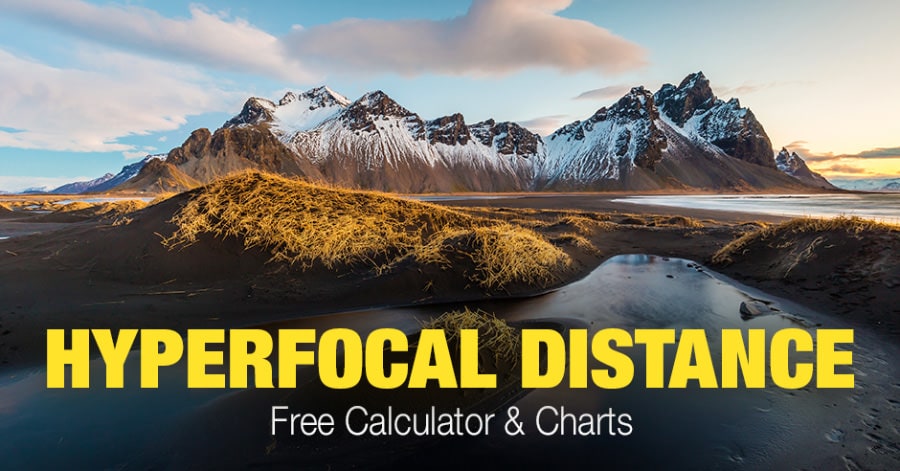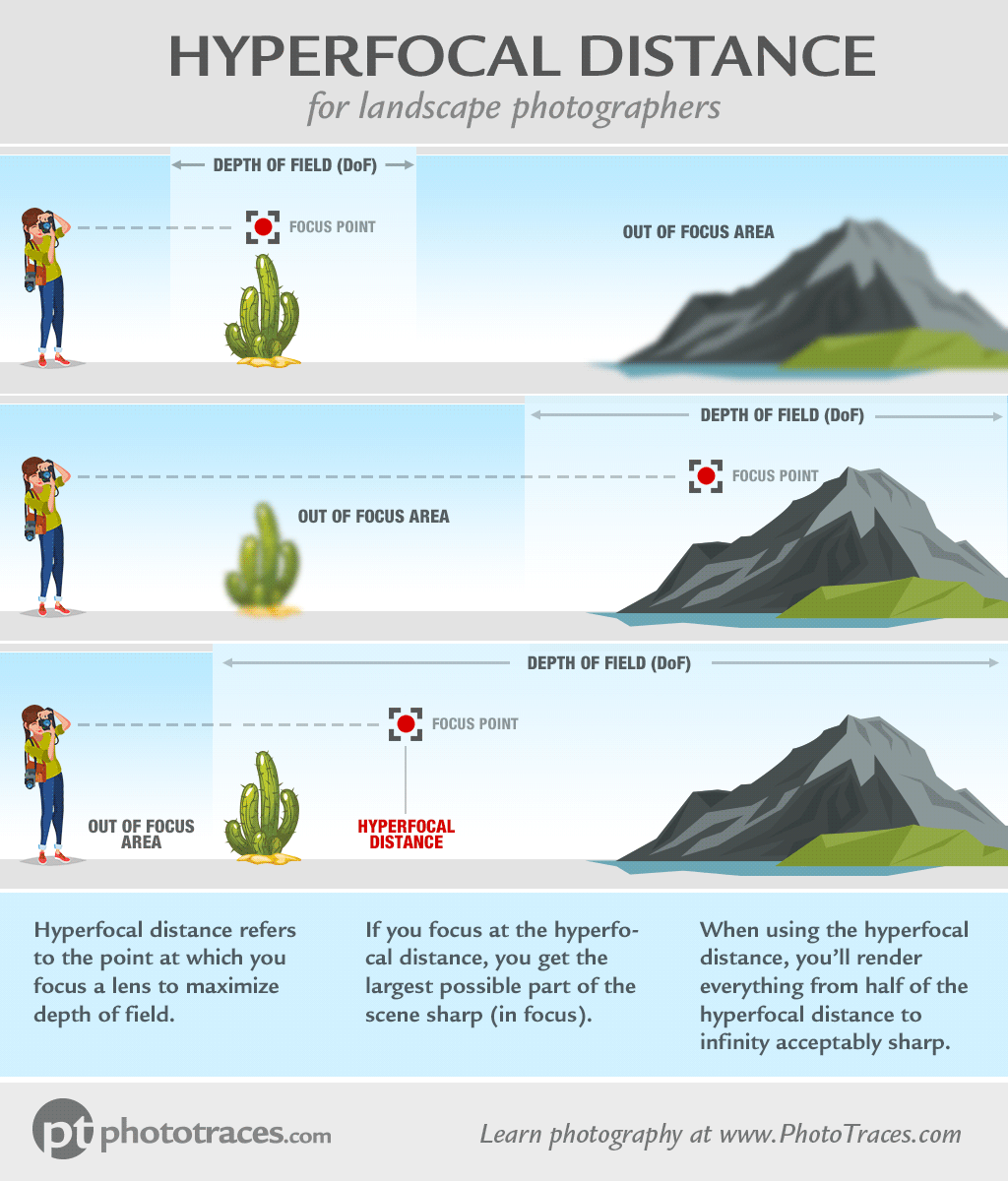If you’re struggling to understand hyperfocal distance in photography, then you’ve come to the right place.

In this article, I’m going to explain everything you need to know about hyperfocal distance, and how you can use it for photos that are sharp from front to back.
In fact, if you desire the sharpest possible landscape photos, you must master hyperfocal distance–because without accurately estimating it, you’ll often end up with blurry foregrounds and/or backgrounds.
Let’s get started.
Maximizing Depth of Field in Landscape Photography
Here’s why the hyperfocal distance matters:
In landscape photography, the goal is to create an image with depth, one that draws the viewer into the scene. This is achieved by including points of interest in the foreground, middleground, and background.
- The foreground subject captures the viewer’s attention.
- The middleground subject moves them further into the scene.
- And the background subject is the final point of focus, where the eye can finally rest.
However, it’s not enough to simply include these subjects.
For the best possible results, the foreground, middleground, and background subject must be sharp; if they’re not, then the viewer won’t feel the same compulsion to continue through the scene, and they may not immediately understand where to focus.

(Note that this is the complete opposite of portrait photography, where the goal is to create images with a sharp subject and a blurry background, so that the background emphasizes the main subject by creating a clear separation between it and the model.)
Now, if you’re taking a landscape photo with lots of depth, and your goal is to keep the scene sharp throughout, then there’s something you must do:
Maximize the depth of field.
This will ensure that everything in the scene, from the nearest foreground subject to the distant sky in the background, is completely in focus.
And that’s where hyperfocal distance really matters.
But before I explain hyperfocal distance in more detail, let’s cover the basics of depth of field:
What Is Depth of Field?
Depth of field (DoF) refers to the amount of your photo that’s sharp, starting at the nearest object that’s sharp, and extending to the most distant object that’s sharp.
Note that the depth of field can be very large, in which case the entire scene may be sharp, from foreground to background.
Or the depth of field can be extremely shallow, when you only have a sliver of the image in focus, and the rest blurred out.
Now let’s take a quick look at the factors that actually affect depth of field:

What Affects Depth of Field?
Depth of field is determined by three variables.
- First, the focal length of your lens influences depth of field, where longer focal lengths result in a shallower depth of field, and shorter focal lengths result in a deeper depth of field, all else being equal.
- Second, your lens’s aperture influences the depth of field, where wider apertures (e.g., f/2.8) results in a shallower depth of field, and narrower apertures (e.g., f/16) results in a deeper depth of field–again, with all else being equal.
- And third, the distance between your lens and your point of focus influences depth of field, with a nearer point of focus producing a shallower depth of field, and a more distant point of focus producing a narrower depth of field.
Make sense?
What Is Hyperfocal Distance? Hyperfocal Distance Definition
Hyperfocal distance refers to the point at which you focus a lens to maximize depth of field.
In other words:
If you focus at the hyperfocal distance, you get the largest possible part of the scene sharp.
Note that, when using the hyperfocal distance, you’ll render everything from half of the hyperfocal distance to infinity acceptably sharp.

As you can see, the hyperfocal distance is an extremely important concept–because you can use it to ensure that your entire image is sharp (by maximizing the depth of field).
And, referring back to the previous section, the hyperfocal distance is determined by your lens’s focal length and your lens’s aperture value. The hyperfocal distance is also influenced by the sensor size of your camera, so you’ll need to pay attention to whether you’re using a full-frame (35mm) camera, a crop-sensor (APS-C) camera, or a different type of camera entirely.
What Is Hyperfocal Distance Focusing?
Hyperfocal distance focusing is a technique where you focus at the hyperfocal distance.
This allows you to maximize depth of field in the scene.
Hyperfocal distance focusing is commonly used by landscape photographers, because it allows for images that are sharp from foreground to background.

How Do You Find the Hyperfocal Distance?
There are a few methods for finding the hyperfocal distance, including a simple rule of thumb (which is relatively accurate, but fails in certain cases), as well as more precise methods, such as hyperfocal distance charts or calculators.
Let’s take a look at each of the options:
Rule of Thumb
The quickest way to estimate hyperfocal distance is using this simple rule:
Focus one-third of the way into the scene.

That way, you get a decent area in front of the hyperfocal distance in focus, as well as a significant distance behind it.
But here’s the problem:
While this rule of thumb works in a lot of cases (around 80%), at the end of the day it gives you an estimate, not a perfect result.
And there will be times when you have a more complex scene, with prominent objects of interest in the foreground.
In such cases, you’ll need a more precise method of calculating your hyperfocal distance, which is where the next couple of methods come into play:
Use Hyperfocal Distance Charts
Hyperfocal distance charts are a more accurate method of calculating hyperfocal distance.
Based on your camera model (which matters thanks to different sensor sizes), you’ll work with a particular chart, one that tells you the hyperfocal distance for specific focal lengths and apertures.
Like this one:
While this is a very accurate method of calculating hyperfocal distance, it can fall short in some situations, because not all focal lengths and apertures will necessarily be taken into account.
Plus, charts give you limited information–generally just the precise hyperfocal distance, and nothing more.
That’s where the next method comes in handy:
Use Hyperfocal Distance Calculators
A hyperfocal distance calculator allows you to input your camera model, your focal length, your aperture, and even your subject distance (in case there’s a particular area of the shot that you absolutely must get sharp).
The calculator will then spit out a precise hyperfocal distance, as well as a near and far limit for depth of field. A hyperfocal distance calculator will often also tell you where the depth of field limits will sit in relation to your subject, which is invaluable when you’re trying to keep a certain subject within the acceptable area of sharpness.
Note that you can find plenty of free online hyperfocal distance calculators, though there are also excellent smartphone apps (which you can easily take with you and use in the field). PhotoPills is an especially popular app, and one definitely worth checking out.
Shortcomings of Hyperfocal Distance Focusing
Here’s one big problem with hyperfocal distance focusing:
While it’ll technically keep the nearest foreground point and the most distant background point acceptably sharp…
…these areas are often only just within the range of acceptable sharpness, so they’ll not be as sharp as they could be.
This is because sharpness fades as you move back (and forward) from the point of focus.
So while the area right around your point of focus (that is, right at the hyperfocal distance) will be ultra-sharp, the areas at the edge of the depth of field range will become much softer (though still within the range of acceptable sharpness).
For this reason, if you’re shooting a scene that involves primarily distant subjects and no prominent foreground objects, you may want to discard the hyperfocal distance focusing technique, and instead simply focus on your distant subjects. That way, you’ll end up with the areas of the shot that matter–the distant subjects–as sharp as possible.

Another issue with hyperfocal distance focusing is that you’ll run into situations where your depth of field, even when maximized, is not enough.
In other words:
Even with the most perfect hyperfocal distance focusing technique, you’ll still end up with blurry areas in your image.
This is because even hyperfocal distance focusing has its limits. It doesn’t magically force your depth of field to encompass the whole scene; instead, it simply maximizes the depth of field that you have available.
That’s where a key alternative to hyperfocal distance focusing comes into play:
Alternative to Hyperfocal Distance Focusing
There will be times when the hyperfocal distance doesn’t achieve the necessary depth of field for a sharp foreground, middleground, and background.
That’s when you’ll want to use another technique:
Focus stacking.

Simply focus on the point of interest in the foreground and take a shot.
Then focus on infinity, and take another shot.
Combine the two images in Photoshop, using Photoshop’s built-in focus stacking tool or by stacking manually (with simple image masking).
That way, you’ll be able to combine the sharp parts of each shot for the crispest possible result.
Hyperfocal Distance In-Depth | Final Thoughts
If you want to capture images that are sharp throughout, then you need to understand hyperfocal distance focusing.
Fortunately, there are some easy methods for determining the hyperfocal distance, even while out shooting.
And if you’re unable to get the result you want with hyperfocal distance focusing, you can always focus stack instead!

